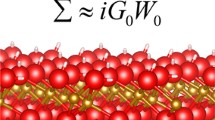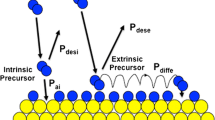Abstract
Fundamental reactivity concepts of relevance to the reactivity of transition metal surfaces are reviewed using elementary quantum-chemical concepts. The Newns-Anderson tight binding model of chemisorption is presented and subsequently used to outline the electronic structure characteristics of weak versus strong chemisorption. Fundamental concepts such as electron localization and surface complex embedding energies are defined and used to help explain surface reactivity. The emphasis here is on establishing an understanding of the surface chemical bond as a function of adatom coordination number, degree of coordinative unsaturation of the surface atoms and electron occupation of the d-type valence electron band. We derive from formal chemisorption theory the important relationships that exist between measured chemisorption properties and the average position of the d-valence electron band. The Newns-Anderson model is also used to show the relationship that exists between the d-band center and the coordinative unsaturation of the metal surface atoms. The general conclusion is that for Group VIII metals the shift of the average energy of the surface local density of states correlates with the strength of the interaction of the surface atoms with the metal atoms next to the surface layer. The same model is then used to analyze the Shustorovich bond order conservation model. The BOC or its modern version UBI-QEP is found to be consistent with a surface interaction potential comprised of a two-body repulsive term along with a constant attractive interaction independent of the number of coordinating atoms. The concepts of weak and strong chemisorption provide a very good basis for the subsequent analysis of the Brønsted-Eyring-Polanyi (BEP) relation. The extreme values of the BEP proportionality constant are related to the concept of loose and tight transition states. This proportionality constant between transition state energy and reaction energy can be expressed in parameters from the Newns-Anderson model by identifying loose transition states with intermediates in which the bond to be activated has not yet been broken, whereas in tight transition states this bond can be considered to be broken. We conclude the paper with an analysis of surface reconstruction. The power of the surface-molecule complex view of chemisorption will be quite apparent. The paper has an extensive introductory section to relate the topics of the four sections that follow with important classical catalytic notions.
Similar content being viewed by others
References
A. Clark, The Theory of Adsorption and Catalysis (Academic, New York, 1970).
G. A. Somorjai, Introduction to Surface Chemistry and Catalysis (Wiley, New York, 1994).
M. Boudart, Adv. Catal. 20, 153 (1969).
M. Che and C. O. Bennet, Adv. Catal. 36, 55 (1989).
C. R. Henry, C. Chapon, S. Giorgio, and C. Goyhenex, in Chemisorption and Reactivity on Supported Clusters and Thin Films, Ed. by R. M. Lambert and G. Pacchioni (Kluwer, 1997), pp. 117–152.
J. H. Sinfelt, J. L. Carter, and D. J. C. Yates, J. Catal. 24, 283 (1972).
W. M. H. Sachtler and R. A. van Santen, Adv. Catal. 26, 69 (1977).
B. Hammer and J. K. Nørskov, Adv. Catal. 45, 71 (2000).
A. Grosz, Top. Catal. 37, 29 (2006).
M. Mavrikakis, B. Hammer, and J. K. Nørskov, Phys. Rev. Lett. 81, 2819 (1998).
E. M. Shustorovich, Surf. Sci. Rep. 6, 1 (1986).
R. Hoffmann, Solids and Surfaces (VCH, 1988).
J. K. Nørskov and N. D. Lang, Phys. Rev. B: Condens. Matter 12, 2136 (1980); J. K. Nørskov, Phys. Rev. B: Condens. Matter 26, 2875 (1982).
B. Hammer, Top. Catal. 37, 3 (2006).
M. J. Puska, R. M. Nieminen, and M. Manninen, Phys. Rev. B: Condens. Matter 24, 3037 (1980).
D. M. Newns, Phys. Rev. 178, 1123 (1969); P. W. Anderson, Phys. Rev. 124, 41 (1961).
M. Neurock et al., to appear.
E. M. Shustorovich, J. Phys. Chem. B 1, 307 (2007).
L. P. Hammett, J. Am. Chem. Soc. 59, 96 (1937).
R. A. van Santen and M. Neurock, Catal. Rev. Sci. Eng. 37, 557 (1993).
R. A. van Santen and J. W. Niemantsverdriet, Chemical Kinetics and Catalysis (Plenum, New York, 1995), pp. 199, 230.
R. A. van Santen and M. Neurock, Molecular Heterogeneous Catalysis (Wiley-VCH, 2006).
O. K. Rice, Statistical Mechanics: Thermodynamics and Kinetics (W.H. Freeman, 1967).
P. Sabatier, La Catalyse en Chimie Organique (Libraire Polytechnique, Paris, 1913).
A. M. Argo, J. F. Odzak, F. S. Lai, and B. C. Gates, Nature (London) 415, 623 (2002).
G. Wulff, Z. Kristallogr. 34, 449 (1901).
J. Wang, C. Y. Fan, K. Jacobi, and G. Ertl, Surf. Sci. 481, 113 (2001).
M. Neurock and D. Mei, Top. Catal. 20, 1 (2002); C. G. M. Hermse, F. Frechard, A. P. van Bavel, et al., J. Chem. Phys. 118, 7081 (2003).
B. P. Crawford and P. Hu, J. Chem. Phys. 124, 044705 (2006).
F. Seitz, The Modern Theory of Solids (McGraw-Hill, New York, 1940).
R. A. van Santen, Theoretical Heterogeneous Catalysis (World Sci., Singapore, 1991).
F. Fréchard, R. A. van Santen, A. Siokon, et al., J. Chem. Phys., p. 8124 (1999).
W. Biemolt, Quantum Chemical Studies in Catalysis: Thesis (Eindhoven, 1995).
M. T. M. Koper, T. E. Shubina, and R. A. van Santen, J. Phys. Chem. B 106, 686 (2002).
N. Lopez and J. K. Nørskov, Surf. Sci. 477, 59 (2001).
N. Mott, Metal-Insulator Transition (Taylor and Fransis, New York, 1974).
E. M. Shustorovich and H. Sellers, Surf. Sci. Rep. 31, 1 (1998).
H. Sellers and E. M. Shustorovich, Surf. Sci. 504, 167 (2002).
L. Pauling, The Nature of the Chemical Bond and the Structure of Molecules and Crystals (Cornell University Press, Ithaca, 1939).
G. S. Hammond, J. Am. Chem. Soc. 77, 334 (1955).
B. S. Bunnik and G. J. Kramer, unpublished.
Q. Ge and M. Neurock, J. Am. Chem. Soc. 126, 1551 (2004).
A. Eichler and J. Hafner, Chem. Phys. Lett. 343, 383 (2004).
J. K. Nørskov, T. Bligaard, A. Logadottir, et al., J. Catal. 209, 275 (2002).
P. van Beurden and G. J. Kramer, J. Chem. Phys. 121, 2317 (2004).
J. K. Nørskov, Surf. Sci. 299/300, 690 (1994).
F. Fréchard and R. A. van Santen, Surf. Sci. 407, 200 (1998).
A. B. Hayden, P. Pervan, and D. P. Woordruff, Surf. Sci. 306, 99 (1994).
J. E. Kirsch and S. Harris, Surf. Sci. 522, 125 (2003).
I. Ciobica and R. A. van Santen, unpublished.
Author information
Authors and Affiliations
Corresponding author
Rights and permissions
About this article
Cite this article
van Santen, R.A., Neurock, M. Theory of surface chemical reactivity. Russ. J. Phys. Chem. B 1, 261–291 (2007). https://doi.org/10.1134/S1990793107040021
Received:
Issue Date:
DOI: https://doi.org/10.1134/S1990793107040021




